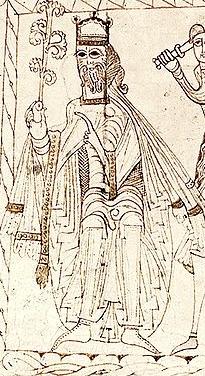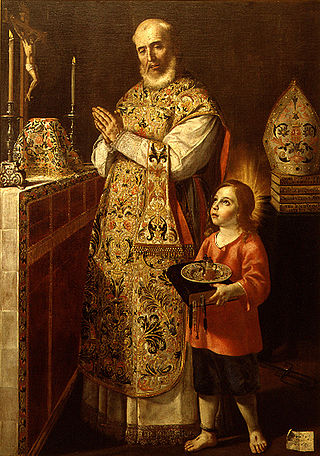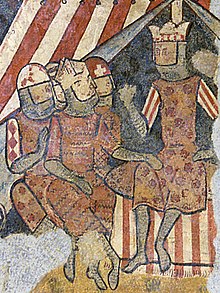
Alfonso II, called the Chaste or the Troubadour, was the King of Aragon and, as Alfons I, the Count of Barcelona from 1164 until his death. The eldest son of Count Ramon Berenguer IV of Barcelona and Queen Petronilla of Aragon, he was the first King of Aragon who was also Count of Barcelona. He was also Count of Provence, which he conquered from Douce II, from 1166 until 1173, when he ceded it to his brother, Ramon Berenguer III. His reign has been characterised by nationalistic and nostalgic Catalan historians as l'engrandiment occitànic or "the Pyrenean unity": a great scheme to unite various lands on both sides of the Pyrenees under the rule of the House of Barcelona.

Alfonso VII, called the Emperor, became the King of Galicia in 1111 and King of León and Castile in 1126. Alfonso, born Alfonso Raimúndez, first used the title Emperor of All Spain, alongside his mother Urraca, once she vested him with the direct rule of Toledo in 1116. Alfonso later held another investiture in 1135 in a grand ceremony reasserting his claims to the imperial title. He was the son of Urraca of León and Raymond of Burgundy, the first of the House of Ivrea to rule in the Iberian peninsula.

Ramiro II, called the Monk, was a member of the House of Jiménez who became king of Aragon in 1134. Although a monk, he was elected by the Aragonese nobility to succeed his childless brother Alfonso the Battler. He then had a daughter, Petronilla, whom he had marry Count Ramon Berenguer IV of Barcelona, unifying Aragon and Barcelona into the Crown of Aragon. He withdrew to a monastery in 1137, leaving authority to Ramon Berenguer but keeping the royal title until his death.

Ramon Berenguer IIIthe Great was the count of Barcelona, Girona, and Ausona from 1086, Besalú from 1111, Cerdanya from 1117, and count of Provence in the Holy Roman Empire, from 1112, all until his death in Barcelona in 1131. As Ramon Berenguer I, he was Count of Provence in right of his wife.
Berenguer Ramon II "the Fratricide" was count of Barcelona from 1076 to 1097. He was the son of Ramon Berenguer I and Almodis of La Marche, and initially ruled jointly with his twin brother Ramon Berenguer II.

Ramon Berenguer IV, sometimes called the Saint, was the count of Barcelona who brought about the union of the County of Barcelona with the Kingdom of Aragon to form the Crown of Aragon.

The Kingdom of Aragon was a medieval and early modern kingdom on the Iberian Peninsula, corresponding to the modern-day autonomous community of Aragon, in Spain. It should not be confused with the larger Crown of Aragon, which also included other territories—the Principality of Catalonia, the Kingdom of Valencia, the Kingdom of Majorca, and other possessions that are now part of France, Italy, and Greece—that were also under the rule of the King of Aragon, but were administered separately from the Kingdom of Aragon.

The Crown of Aragon was a composite monarchy ruled by one king, originated by the dynastic union of the Kingdom of Aragon and the County of Barcelona and ended as a consequence of the War of the Spanish Succession. At the height of its power in the 14th and 15th centuries, the Crown of Aragon was a thalassocracy controlling a large portion of present-day eastern Spain, parts of what is now southern France, and a Mediterranean empire which included the Balearic Islands, Sicily, Corsica, Sardinia, Malta, Southern Italy and parts of Greece.

Raymond of Penyafort was a Catalan Dominican friar in the 13th century, who compiled the Decretals of Gregory IX, a collection of canonical laws that remained a major part of Church law until the 1917 Code of Canon Law abrogated it. He is honored as a saint in the Catholic Church and is the patron saint of canon lawyers.

Peter Nolasco, O. de M. was a Catholic priest known for founding the Royal and Military Order of Our Lady of Mercy of the Redemption of the Captives with approval by Pope Gregory IX in 1230.

Ramon Borrell was count of Barcelona, Girona and Ausona from 992. He was the son of Borrell II of Barcelona and Letgarda of Rouergue, and was associated with his father in ruling the counties from 988.

The County of Barcelona was a polity in northeastern Iberian Peninsula, originally located in the southern frontier region of the Carolingian Empire. In the 10th century, the Counts of Barcelona progressively achieved independence from Frankish rule, becoming hereditary rulers in constant warfare with the Islamic Caliphate of Córdoba and its successor states. The counts, through marriage, alliances and treaties, acquired or vassalized the other Catalan counties and extended their influence over Occitania. In 1164, the County of Barcelona entered a personal union with the Kingdom of Aragon. Thenceforward, the history of the county is subsumed within that of the Crown of Aragon, but the city of Barcelona remained preeminent within it.

The Royal, Celestial and Military Order of Our Lady of Mercy and the Redemption of the Captives, also known as the Mercedarians, is a Catholic mendicant order established in 1218 by Peter Nolasco in the city of Barcelona, at that time the capital of the Principality of Catalonia, part of the Crown of Aragon, for the redemption of Christian captives. Its members are most commonly known as Mercedarian friars or nuns. One of the distinguishing marks of the Order of the Blessed Virgin Mary of Mercy is that, since its foundation, its members are required to take a fourth vow: to die, if necessary, for another who is in danger of losing their faith. The Order exists today in 17 countries.

The Archdiocese of Barcelona is a Latin metropolitan archbishopric of the Catholic Church in northeastern Spain's Catalonia region.

Peter Pascual, in Latin originally Petrus Paschasius, was a supposed Mozarabic theologian, bishop, and martyr. His very existence has been called into question by recent scholarship.

Joan Gilabert Jofré (1364–1417), also known as Padre Jofré or Pare Jofré, was a member of the Christian religious Order of Mercy and the founder of what is claimed to be the first psychiatric care institution in Europe, in Valencia, Crown of Aragon, in medieval Spain.

The conquest of the island of Majorca on behalf of the Roman Catholic kingdoms was carried out by King James I of Aragon between 1229 and 1231. The pact to carry out the invasion, concluded between James I and the ecclesiastical and secular leaders, was ratified in Tarragona on 28 August 1229. It was open and promised conditions of parity for all who wished to participate.

The Battle of Portopí was an open field military conflict between the Almohad troops that occupied the island of Majorca and the Christian army led by King James I the Conqueror with the aim of annexing it to the Crown of Aragon in order to expand their domain. It was carried out at various points in the current Sierra de Na Burguesa, approximately halfway between the current resort town of Santa Ponsa and the City of Majorca. It was the second major battle in the campaign for the conquest of the island of Majorca initiated by the Aragonese king.
The Battle of Mollerussa took place in the south of the county of Urgell on 11 or 14 September 1102. In the battle, Count Ermengol V was defeated and killed by an Almoravid army. Mollerussa lies halfway between Bellpuig and Lleida and is the largest town in the Pla d'Urgell.
Palou is a Catalan surname. Notable people with the surname include:


















